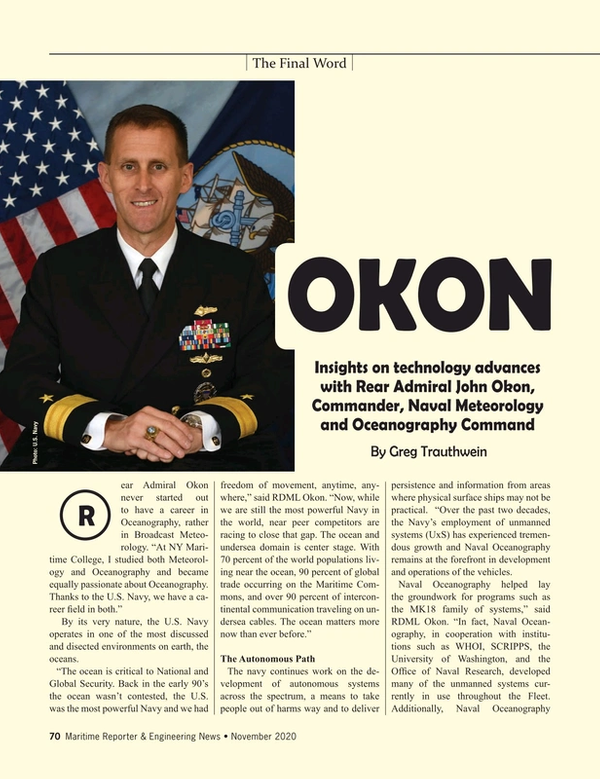
Interview: Rear Admiral John Okon, Commander, Naval Meteorology and Oceanography Command, US Navy
Insights on technology advances with Rear Admiral John Okon, Commander, Naval Meteorology and Oceanography Command.
Rear Admiral Okon never started out to have a career in Oceanography, rather in Broadcast Meteorology. “At NY Maritime College, I studied both Meteorology and Oceanography and became equally passionate about Oceanography. Thanks to the U.S. Navy, we have a career field in both.”
By its very nature, the U.S. Navy operates in one of the most discussed and disected environments on earth, the oceans.
“The ocean is critical to National and Global Security. Back in the early 90’s the ocean wasn’t contested, the U.S. was the most powerful Navy and we had freedom of movement, anytime, anywhere,” said RDML Okon. “Now, while we are still the most powerful Navy in the world, near peer competitors are racing to close that gap. The ocean and undersea domain is center stage. With 70 percent of the world populations living near the ocean, 90 percent of global trade occurring on the Maritime Commons, and over 90 percent of intercontinental communication traveling on undersea cables. The ocean matters more now than ever before.”
- The Autonomous Path
The navy continues work on the development of autonomous systems across the spectrum, a means to take people out of harms way and to deliver persistence and information from areas where physical surface ships may not be practical. “Over the past two decades, the Navy’s employment of unmanned systems (UxS) has experienced tremendous growth and Naval Oceanography remains at the forefront in development and operations of the vehicles.
Naval Oceanography helped lay the groundwork for programs such as the MK18 family of systems,” said RDML Okon. “In fact, Naval Oceanography, in cooperation with institutions such as WHOI, SCRIPPS, the University of Washington, and the Office of Naval Research, developed many of the unmanned systems currently in use throughout the Fleet.
Additionally, Naval Oceanography fielded SLOCUM gliders in 2010, and by 2019 was the first organization to successfully deploy and operate over 100 unmanned systems simultaneously from one location, the Naval Oceanographic Office’s Glider Operations Center.”
In the past 10 years, unmanned systems capabilities have continued to expand, and today RDML Okon counts an inventory approximately 200 unmanned systems, ranging from man portable littoral expeditionary units to the larger 6000M deep ocean systems.
“These systems are force multipliers for us to provide critical environmental knowledge across the globe to the meet the operational needs of the Fleet. Operating unmanned systems are part of everyday life across a number of Naval Oceanography commands to include a fleet of buoyancy gliders, unmanned surface vehicles, and unmanned underwater vehicles that effectively enable mine warfare, special warfare, and safety of navigation. The expanded roles of unmanned systems in environmental intelligence operations means their place in the warfighting tool kit is well entrenched.”
 An autonomous Z-Boat & USS Arizona Memorial. Photo: U.S. Navy
An autonomous Z-Boat & USS Arizona Memorial. Photo: U.S. Navy
- The Future is Now
According to RDML Okon, utilization of unmanned systems will continue to expand throughout Navy operations.
“Early successes with the MK18 family of unmanned underwater systems demonstrated that unmanned systems can extend the fleet’s reach, direct our talented members to other tough problems, and improve warfighter safety,” he said. “As AI, autonomy, and endurance mature and improve our ability to sense the environment and grow the tactical advantage. Coupled with efficiency in data handling, dissemination and onboard processing Naval Oceanography will maintain our advantage in the information age.” While unmanned systems come with tremendous promise, hurdles remain to deploy, utilize and recover these systems efficiently and effectively. “People often tout power management as the greatest limitation, but we have been making steady advances in endurance,” said RDML Okon. “In reality, true autonomy and extended communications remain the barriers to broad ocean unmanned operations. Marine surface and submerged systems operate in very hostile environments and are challenged daily by that environment. The communications to these systems is never an assured success. UMS systems need to be able to maneuver in that ocean environment, make adjustments according to the challenges that ocean environment presents and most importantly complete the objective or task with very little or often no communications. Energy demand remains a challenge.” While technological evolution is central to RDML Okon and his teams’ ultimate success, he looks beyond the technology paradigm is assessing the path forward to maximize our efficiencies in the most hostile and corrosive environment on the planet.
“Technology is important and it seems like many folks are chasing the next best thing. In my opinion, it is the commitment from every aspect of our country, from government, to academia to industry, to work together to solve hard problems in the ocean for our economic prosperity and defense of our country,” said RDML Okon. “The ocean has no borders, we must work together to develop a culture of connectedness ... in the end our greatest advantage is people and partnerships.”
 Photo: U.S. Navy
Photo: U.S. Navy
Read Interview: Rear Admiral John Okon, Commander, Naval Meteorology and Oceanography Command, US Navy in Pdf, Flash or Html5 edition of November 2020 Maritime Reporter
Other stories from November 2020 issue
Content
- Engineering Ethics, Seaworthiness and the Right of Clients to Kill Themselves page: 14
- Cavotec, ASKO Power Forward on Autonomous, Zero-Emission Fleet page: 32
- Wilson Sons: Inside Brazil’s Workboat Goliath page: 36
- Addressing the New IMO Guidelines for Second Generation Intact Stability page: 52
- Interview: Rear Admiral John Okon, Commander, Naval Meteorology and Oceanography Command, US Navy page: 70


